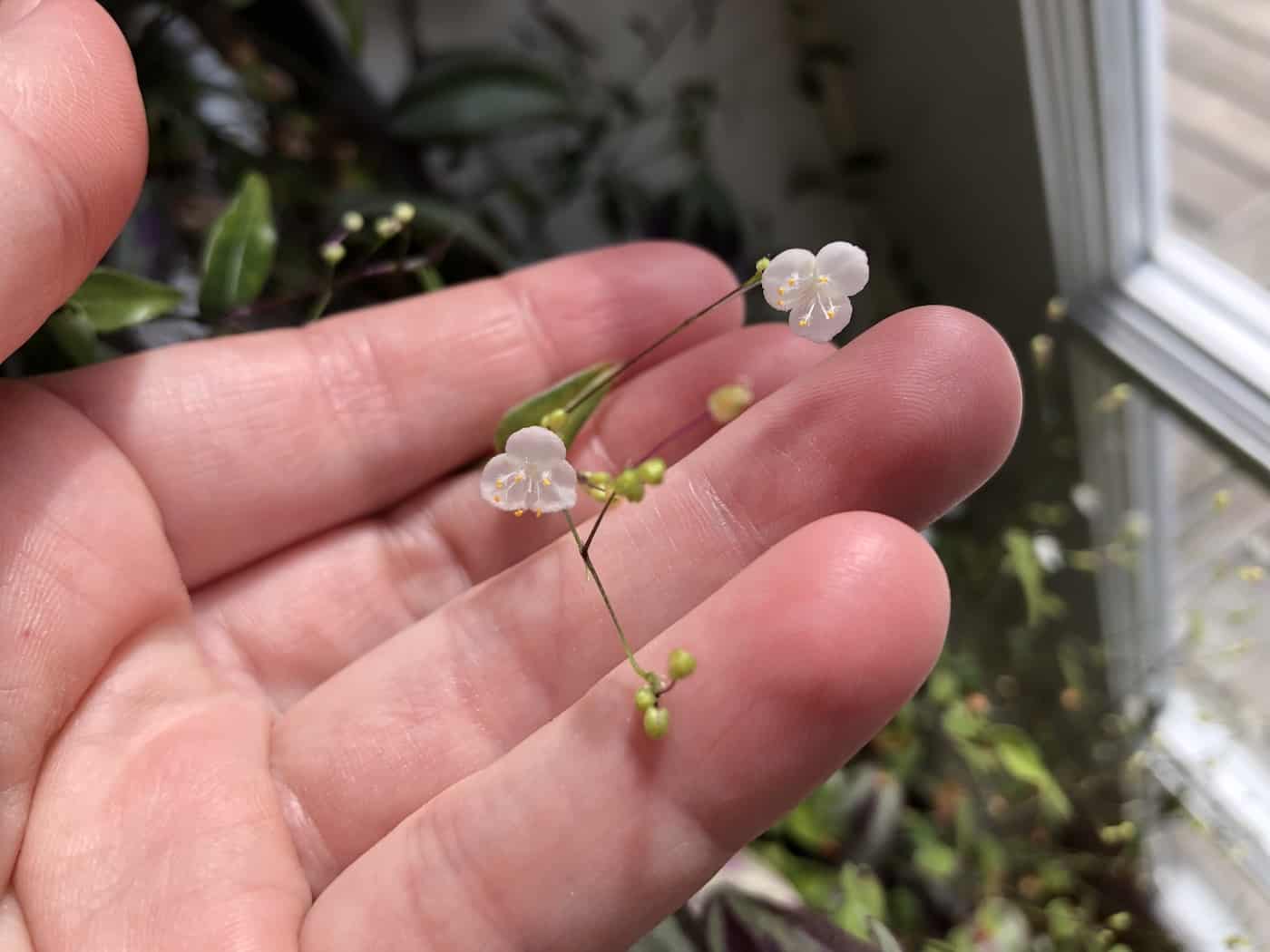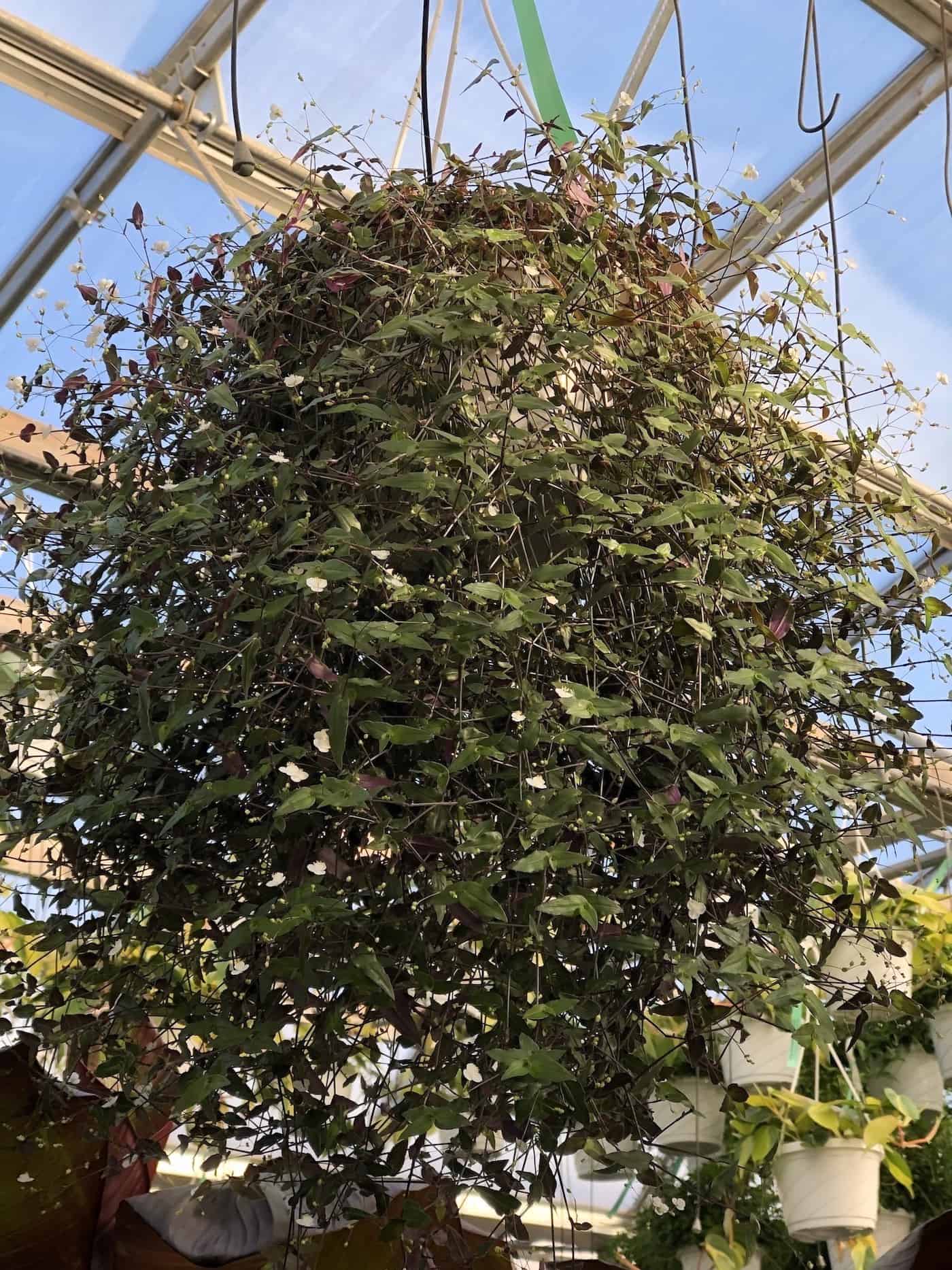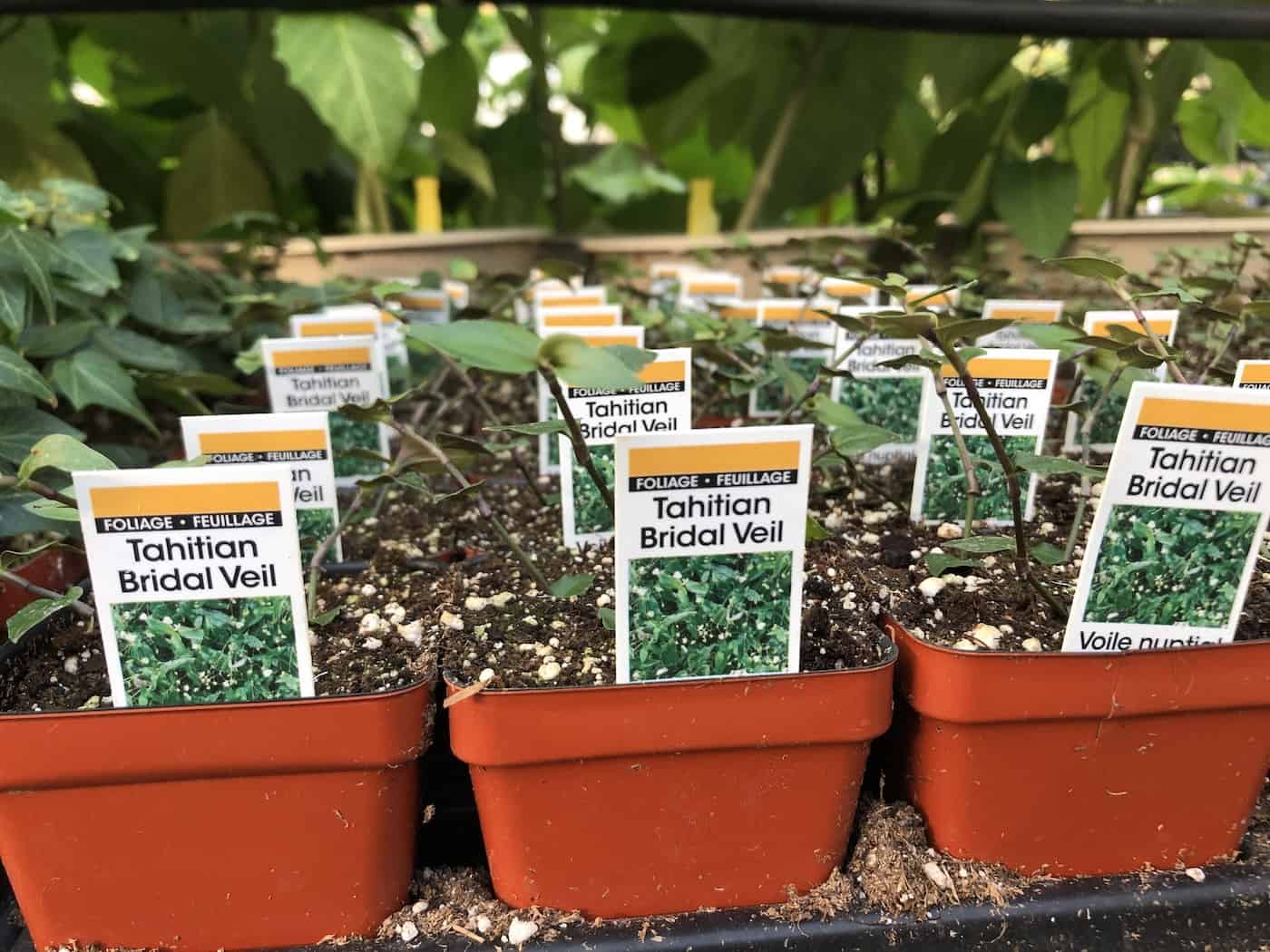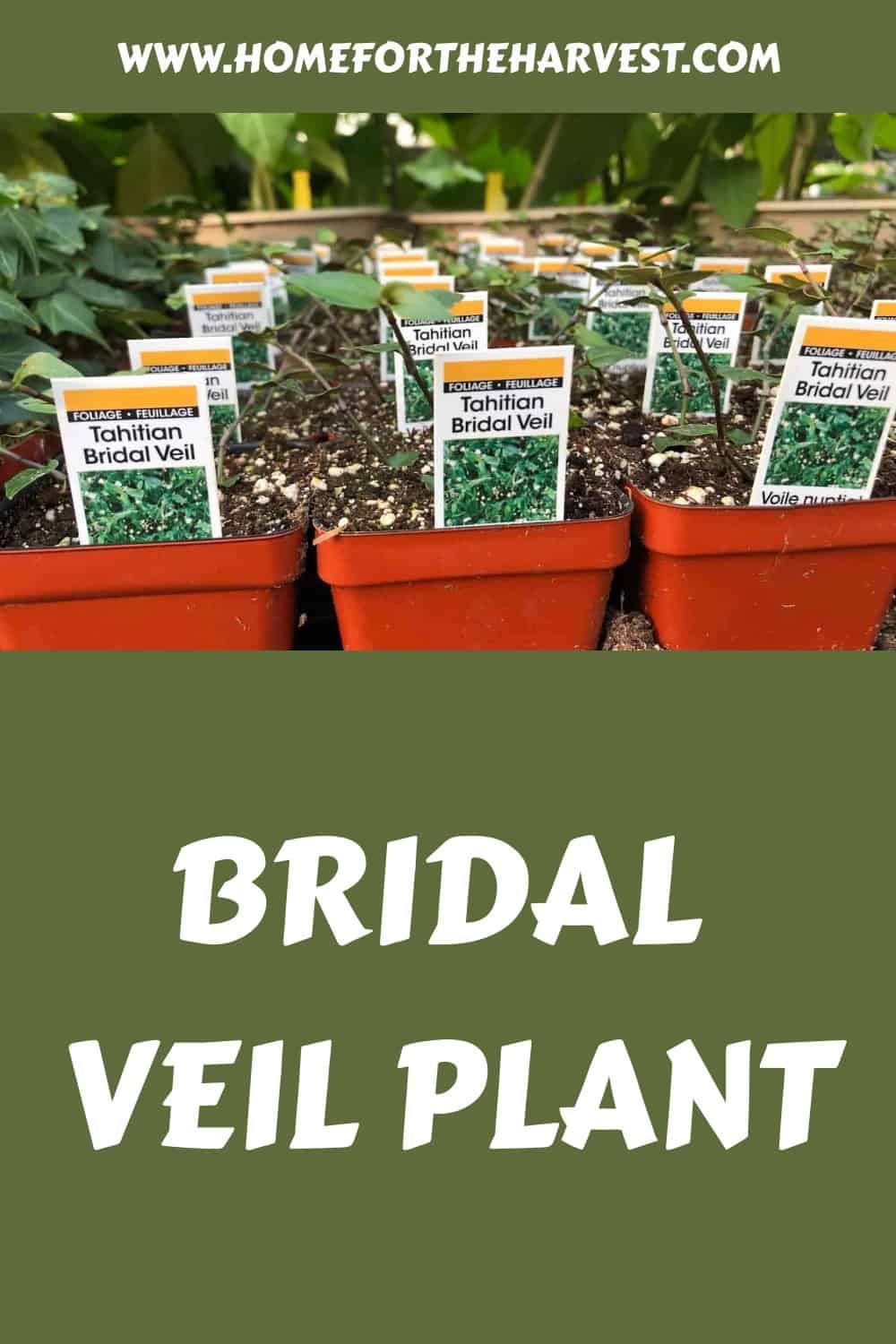Bridal Veil Plant is one of the loveliest houseplants to add to your growing plant collection. And fortunately, there as low-maintenance as they are beautiful!
Bridal Veil Plants are trailing tropical plants with delicate dark green and purple foliage and tiny white flowers. These easy-to-grow plants are commonly grown as houseplants, in hanging baskets, and as groundcover plants in warm climates. Sometimes called Tahitian Bridal Veil, these plants are native to Jamaica, Mexico, and Argentina. Bridal Veil Plant was previously classified as a Tradescantia but is now given the botanical Latin name Gibasis geniculata (Gibasis genus).
Read on to learn all about Bridal Veil Plant!

Bridal Veil plant: The basics
Bridal Veil Plant (Gibasis geniculata), also known as Tahitian Bridal Veil, is a trailing plant most commonly cultivated as a houseplant. Bridal Veil Plants are native to parts of the West Indies and Central America.
Bridal Veil Plants have very thin, delicate, dark green stems. The dark green leaves are narrow and pointed, with a purple underside. The Bridal Veil Plant produces masses of tiny white flowers hanging down its stems, which give the whole plant an ethereal look reminiscent of a bridal veil.
Bridal Veil Plants are easy to grow as houseplants, as container-grown outdoor plants (often in hanging baskets, and as groundcover plants in warm climates. They grow best in warm temperatures and humid air. While they do require high light levels, they should be placed in an area shielded from direct sunlight. Harsh, afternoon sunlight can scorch the leaves of this understory plant. Bring the Bridal Veil Plant indoors before the threat of frost during the cooler months. Some Bridal Veil Plants hit by a mild frost may grow back from their roots.
Bridal Veil plants can be identified by their cladodes (flattened stems), which occur in sets of 3. Once you see one of these plants, it’s easy to see where it got its name. Bridal veil plants get their name because they resemble a bridal veil in some ways. During most parts of the year, you will be able to find beautiful and delicate white flowers that sprout from the long hanging stems. Their lovely appearance has caused these plants to be one of the most popular houseplants.

How to care for Bridal Veil plant
When left to grow to their full size, Bridal Veil plants can reach up to eighteen feet in length! These plants are large, however, they are typically cut to better thrive as houseplants. Not many homes can accommodate these plants at their full size. They can grow well in many conditions, but their optimal temperature is fairly humid and tropical.
Lighting for Bridal Veil plants
Bridal Veil Plants need high light levels but can be harmed by direct sunlight. Give the leaves access to bright, indirect sunlight, or provide artificial lighting with a plant light. You can use a standalone grow light or group it together with other houseplants under a plate-style LED diode grow light. Bright, indirect light allows the plant to photosynthesize and make energy, but harsh direct sunlight can scorch the leaves.
Watering Bridal Veil plant
How often you need to water your plant depends a lot on the type of soil you are using, as well as the ambient humidity, temperature, and any natural precipitation. Bridal Veil Plants should be watered whenever you notice the soil is drying out. You do not want to dry out your plant completely, and therefore you will want to water it every time the top 1″ of the soil is dry.
Fertilizing Bridal Veil plant
Bridal Veil Plants grown in containers should be fertilized during the spring and throughout summer, as they are isolated from their natural ecosystem and the nutrients it would provide.
Best potting soil for Bridal Veil plant
Use a high-quality, organic, lightweight potting mix for your Bridal Veil Plant. These tropical plants typically grow in rather nutrient-poor soil, so avoid growing them in a rich, heavy, outdoor soil mix. Use fresh potting soil to repot Bridal Veil Plant to minimize the transfer of soil-borne diseases.
Planters for Bridal Veil
The most important thing to remember when purchasing your pot is to ensure it has drainage holes. Bridal Veil Plants do not handle overly moist conditions well and therefore need good drainage. Bridal Veil Plants are most commonly used as hanging wall plants, which can be a problem as these types of containers do not always have drainage holes.
Bridal Veil Plants are susceptible to root rot. This can occur with or without a drainage hole. However, it is almost unavoidable if you do not have a drainage hole. If there is nowhere for the excess water to go, it will stagnate and rot your beautiful plant.
Humidity for Bridal Veil Plants
Bridal Veil Plants grow best in a moderately humid environment. They will tolerate dry air better than some other tropicals, but it’s best to add some humidity to the air in dry winter climates. The most effective way to raise humidity levels is with a humidifier. You can use a regular ultrasonic mist humidifier or opt for a specialty humidifier from a plant store.
Temperature for Bridal Veil Plants
Bridal Veil Plants prefer warm, tropical weather. Keeping the thermostat at a constant temperature between 50°-70° Fahrenheit is ideal. Anything colder than 50° is too cold for the plant and is not recommended. The plant will not be able to survive in cold weather. You probably won’t want your home to be cooler than that either!
In most non-tropical climates, it is recommended to keep your Bridal Veil Plant indoors for most of the year. Although it is possible to keep the plant outside, it requires optimal conditions. During the summer months, the plant can be brought outdoors for a “summer vacation”, but it must be placed in an area protected from direct sunlight. Direct sunlight can easily scorch the leaves (especially if the plant has been indoors over the winter).
Air ventilation is important for bridal veil plants as well. Placing these plants under a heating or cooling vent is discouraged as this can cause damage to the plant. In addition, you will want to ensure there are no sudden changes in temperature as your plant may not be able to withstand the changes.
Pruning Bridal Veil plants
Pruning the Bridal Veil Plant is important. Removing dead or dying flowers can help promote further blooming and will make your plant more attractive. You will also want to trim your plant regularly as this will result in a happier and healthier plant.
Common pests that affect Bridal Veil plant
Bridal Veil Plants are quite pest and disease resistant. They are also very resistant to damage from deer, so you won’t see any of them if you decide to plant a Bridal Veil Plant in your home garden or in a pot on the patio.
If you want to prevent any pests from affecting your Bridal Veil Plant, spray a gentle organic pesticide on it periodically. You may want to do this when you repot your plant, when you add fertilizer to the soil, and/or after bringing it inside after a patio plant vacation.
Common diseases that affect Bridal Veil plant
Plant diseases such as root rot can affect Bridal Veil plant. Most plant diseases are fungal and are exacerbated by moist soil and still, moist air.
Start treatment by moving the plant to an area with good air circulation and lower air humidity. Then use a natural fungicide to treat the plant for the disease.
When does the Bridal Veil plant grow best?
The Bridal Veil Plant grows beautiful flowers from mid-spring until early fall. The winter is the resting period for the Bridal Veil Plant and the plant should therefore be kept drier. In order to get ready for the next flowering season, which starts in March and ends in September, the soil should not be kept quite as moist.

How to re-pot Bridal Veil plants
The first step is to remove your Bridal Veil plant from its current container. Do this gently and do not rip it out, as this can damage the roots and the foliage. You will want to loosen it until it slides out of the container easily. You may need to water the soil to make it easier to work with. Soil knives can be used to help encourage the removal of your plant if it is in a ceramic pot.
The second step is to prune your plant. If there are any dead leaves or flowers, then you will want to remove them.
The third step is to remove the old soil from the container and then add fresh soil. After adding the soil, you will want to pack it down so it is firmer. This will promote root growth.
The fourth step is to place the Bridal Veil plant back in the container. Loosen up the roots if the plant was rootbound in its previous container. You will then want to add some additional soil around the plant so it is more secure.
The fifth step is to water your Bridal Veil plant. You will want to ensure your plant is moist and is not lacking in water. When you water your plant after the initial repotting, you will not want to water it again for about a week. You will want to give it time to get used to its new home before you resume the regular watering schedule.
Common issues growing Bridal Veil plants
Bridal Veil Plants are not necessarily difficult to care for. These plants do however require some degree of care and attention. If they are not kept in the proper conditions, you may notice them turning brown. If this occurs, you will want to ensure they are receiving adequate amounts of light and water. Too much or too little light and water can be an issue. You will want to resolve the problem immediately to increase the chances of saving your plant.
Problems with lighting
There should be no extremes when it comes to lighting and Bridal Veil Plants. Both extremes can be equally damaging and should be avoided. Bridal Veil plants need bright, indirect light. If the plant is kept in direct sunlight, the foliage may scorch. Too much light can cause the plant to dry out quickly and therefore result in it needing to be watered more often.
It is equally important to ensure that the bridal veil plant does not lack light. If the plant does not receive any light, then it will not bloom and grow properly.
Problems resulting from improper watering
Proper watering practices are one of the most important parts of caring for a plant. Each type of plant is unique in its watering needs and so it is crucial to make sure you know exactly how to care for every one of your individual plants. Watering your Bridal Veil Plant too much or too little can be problematic as it can result in browning.
One of the most common issues for a bridal veil plant is overwatering. These plants like to be wet, but not drown in water. When they become oversaturated, the roots start to rot which then turns the foliage of the plant brown. Having a drainage hole is important to have in your pot as it will help to drain any excess water. However, if your pot does not have any drainage holes, then you will want to consider putting stones in the bottom.
If the plant is not watered enough, then it may turn brown as well. It is a common occurrence for a plant to turn brown if it dries out. Try and keep the soil moist and do not let it become too dry.






